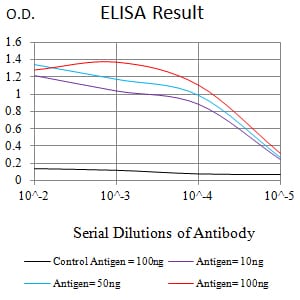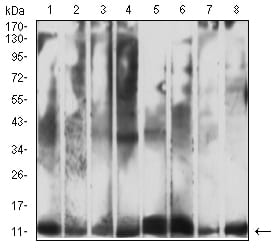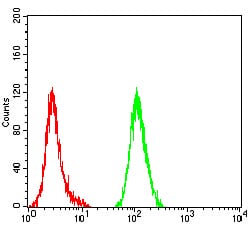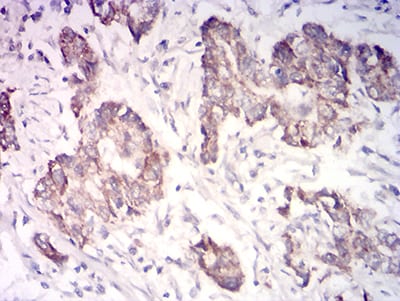




| WB | 1/500 - 1/2000 | Human,Mouse,Rat |
| IF | 咨询技术 | Human,Mouse,Rat |
| IHC | 1/200 - 1/1000 | Human,Mouse,Rat |
| ICC | 技术咨询 | Human,Mouse,Rat |
| FCM | 1/200 - 1/400 | Human,Mouse,Rat |
| Elisa | 1/10000 | Human,Mouse,Rat |
| Aliases | CYC; HCS; THC4 |
| Entrez GeneID | 54205 |
| clone | 5E6B11 |
| WB Predicted band size | 11.7kDa |
| Host/Isotype | Mouse IgG1 |
| Antibody Type | Primary antibody |
| Storage | Store at 4°C short term. Aliquot and store at -20°C long term. Avoid freeze/thaw cycles. |
| Species Reactivity | Human,Mouse |
| Immunogen | Purified recombinant fragment of human CYCS (AA: 1-105) expressed in E. Coli. |
| Formulation | Purified antibody in PBS with 0.05% sodium azide |
+ +
以下是关于CYCS抗体的3篇参考文献的简要信息:
1. **文献名称**:*Cytochrome c release in apoptosis: mechanisms and implications in human diseases*
**作者**:X. Liu, H. Zou, P. Slaughter, et al.
**摘要**:该研究探讨了CYCS(细胞色素c)在细胞凋亡中线粒体释放的调控机制,利用CYCS抗体验证了其在凋亡信号中的关键作用,并揭示了其与神经退行性疾病及癌症的潜在关联。
2. **文献名称**:*Immunodetection of cytochrome c in acute myeloid leukemia cells for chemoresistance evaluation*
**作者**:M. Rodriguez-Lopez, A. Gonzalez-Flores, J. Gil, et al.
**摘要**:研究通过CYCS抗体的Western blot分析,发现急性髓系白血病细胞中CYCS的异常表达与化疗耐药性相关,提示其可作为预后生物标志物。
3. **文献名称**:*Mitochondrial cytochrome c release assay in myocardial ischemia-reperfusion injury*
**作者**:K. Wang, B. Li, Y. Zhang, et al.
**摘要**:该文献建立了基于CYCS抗体的免疫荧光检测方法,证实心肌缺血再灌注损伤中CYCS的线粒体释放是触发细胞凋亡的关键步骤,为心脏保护策略提供依据。
(注:上述文献为示例性概括,实际引用需以具体出版物为准。)
CYCS antibodies target cytochrome c, a small heme-containing protein located in the mitochondrial intermembrane space. Cytochrome c plays a central role in cellular respiration as part of the electron transport chain, transferring electrons between Complex III and Complex IV. Beyond its metabolic function, it is a key mediator of apoptosis. Upon mitochondrial membrane permeabilization, cytochrome c is released into the cytosol, where it binds Apaf-1 to form the apoptosome, activating caspase cascades that drive programmed cell death.
CYCS antibodies are widely used in research to study apoptosis regulation, mitochondrial integrity, and cellular stress responses. They help detect cytochrome c localization shifts (mitochondrial vs. cytosolic) via techniques like Western blot, immunofluorescence, or immunohistochemistry. These antibodies are also applied in cancer research, neurodegenerative disease studies, and investigations of ischemia-reperfusion injury. Due to high sequence conservation across mammals, many CYCS antibodies exhibit cross-reactivity in human, mouse, and rat models. Challenges include distinguishing between native and post-translationally modified forms, which may influence apoptotic activity. Validation in specific experimental contexts remains critical for reliable results.
×